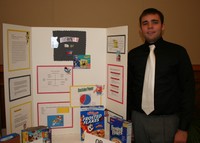Rutgers-Camden Student Studies Marketing Strategies Geared to Children

Daniel Walsh, a marketing major at Rutgers–Camden, is investigating marketing strategies for children for his research project, “Branding to Children: A Gateway to Marketing Success.”
The project has been selected for inclusion in the Princeton Undergraduate Research Symposium at Princeton University on May 4. Student participants have the opportunity to interact with other students and faculty judges in a wide variety of fields and compete for the chance to win cash prizes. Harold Kroto, the 1996 Nobel Prize winner in chemistry, will deliver the keynote speech at the event.
Walsh was chosen for the symposium after an online registration process that required a detailed description of his project.
Two other students, Sheri Bowman of Willingboro and Monica Bennett of Berlin, are also participating in the Princeton Undergraduate Research Symposium. They are working together on a project called, "Categorical Comparisons of Erotic Films Intended for Male Viewers Versus Those Intended for Female Viewers."
The event features student abstracts in natural sciences, social sciences, computer science, mathematics, and engineering disciplines. Entries in other disciplines are accepted on a case-by-case basis.
“My project looks at how children react to brands,” says Walsh, a Bellmawr resident. “For example, how would a child react to a Frosted Flakes cereal with Tony the Tiger on the box compared to a generic box?”
Walsh says a cereal box adorned with a cartoon mascot could not only influence a child’s desire to want one brand over another, but also alter their taste perception.
“By analyzing previously compiled data, I’ve found that 59 percent of children from the ages of 2-14 are dictating what kind of product their parents buy because they want what’s on the box,” Walsh says.
The Gloucester Catholic High School graduate is in the process of researching previously documented data about branding to children and will collect his own data this summer by surveying young children from local schools.
Earlier this month, Walsh presented his project at the Rutgers–Camden Celebration of Undergraduate Research and Creative Activity, where more than 40 projects were on display. During the event, he asked visitors to choose between a generic box of fruit snacks and a box featuring Buzz Lightyear of Toy Story fame.
“Almost everyone chose the Toy Story box,” he says. “That’s not surprising because that’s what they connect with.”
Walsh says he thinks food companies can and should use cartoon characters to their advantage in marketing healthy foods.
“I want to know why healthy food companies haven’t tried to get a character like Buzz Lightyear on their product,” he says. “Children are going to want certain types of foods because they connect with the product. If we were to sell celery with a Disney character on the label, would the child be more likely to eat celery? Would it taste better to them?”
Walsh, a senior who will graduate in January 2012, says he plans to pursue a career in sales or product development and his research project is helping him to achieve that goal.
“My research has provided me a much deeper understanding of all the factors that influence the big decisions of major companies,” he says. “Understanding the brand is an important part of working for any major company. A sales representative must understand the entire scope of the brand. It’s the same for product development. Knowing how the marketplace views your brand is the key to developing and maintaining any product mix.”
-30-
Media Contact: Ed Moorhouse
(856) 225-6759
E-mail: ejmoor@camden.rutgers.edu